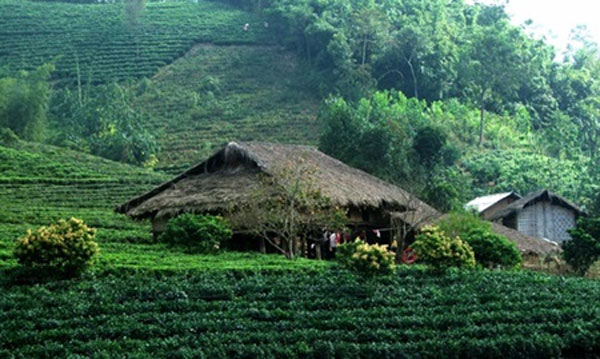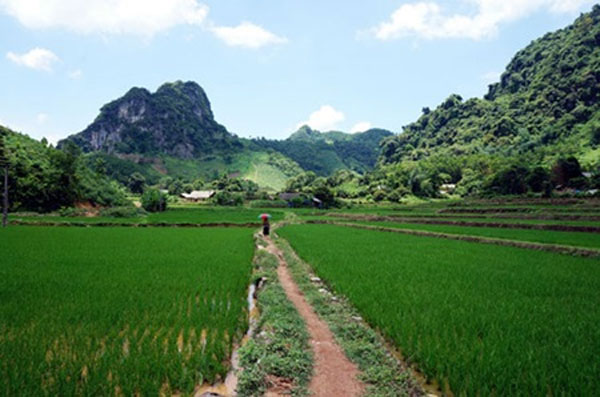
|
|
House on a hill: Plantations dot the stunning countryside in Thai Nguyen Province. — Photo yeutre.vn
|
The destination is not even familiar to many Vietnamese though it is located only 120km from the capital.
To me, the location proved to be an ideal weekend destination, where I also met other city dwellers, who were tired of high-rises and the suffocating atmosphere of the city.
I started my journey to the mountains early in the morning. There are two ways to reach Vo Nhai from Ha Noi. The first route is the National Highway No 3 or Ha Noi – Thai Nguyen Expressway for 80km and from there take the National Highway no 1B for another 40km.
The second route is from the National Highway No 1 between Ha Noi and Lang Son, before turning off to Provincial Highway 242 at Huu Lung junction.
We chose the second way, which is longer with a rougher road, but proved to be interesting.
I had heard about the stunning beauty of Ho Nui Coc, wild and the tranquil ATK guerrilla base in the northern province of Thai Nguyen, but the feeling of driving a car along the deserted Provincial Highway 242, in the middle of the hills that is accompanied by a small river, passing green tea plantations, is quite an alien experience.
While taking a break by the roadside in the Dan Tien Commune area, we met a local farmer named Long who told us the river was called Rong (Algae).
"The river water is clear and green all the year round," he said. "There is a lot of algae under the river bed, and that is why it has been given that name."
From time to time, we saw some small bamboo fishing boats on the river. The waters reflected the hills of the tea plantations on its clear and smooth surface. The scenery resembled a masterpiece painting of autumn. Here and there, the "painting" was dotted with very old trees on the river banks. I am sure no one would ever know how old they were.

|
|
Path less travelled: Tourists make their way to the Phoenix Mountains. — Photo hanotour.com.vn
|
On the hills, people of various ethnic communities such as Tay, Nung and Kinh went farming early in the morning. They picked up the tea leaves, got rid of wild grass and dug up the ground, talking and laughing. Their sounds enlivened up the "autumn painting".
We finally reached Dinh Ca, the capital town of Vo Nhai District before exploring beautiful landscapes of the area.
Driving 30km more to the northwest of the town, we arrived at Than Sa Commune. We rolled down the car windows to fill our lungs with fresh air. Echoing in the wind was the sound of a strong running water stream.
As we reached the sound, what appeared before our eyes was a waterfall rushing down from a mountain cliff at a height of some 30m. At Mua Roi (Rain) Waterfall, as it is called, the water source poured through mossy cliffs covered by a dense growth of trees and plants.
The sound of running water and twittering birds made us relax for a few hours by the waterfall. The hustle and bustle seemed to have been wiped away from our lives by the cool breeze that brought the wild scent of grass and flowers.
We visited a hamlet of the Mong ethnic group nearby, where we chatted with locals and tasted men men (cake made from corn powder), vegetable soup and smoked pork.
We then followed the Than Sa Streamline to a cave up Nguom Mountain, where scientists had found various traces of an ancient civilisation that lived some 30,000 years ago.
On Nguom Mountain at Trung Son Village, scientists had discovered a lot of snail shells and animal bones, which proved that the area used to be residential area of ancient people.
Nowadays, visitors can still find plenty of snail shells in front of Mieng Ho (Phieng Tung) Cave on the mountain. From the middle of Nguom Mountain, we could see a large area of rivers, mountains and fields below. There was a big stone roof, under which scientists had excavated three skeletons of ancient people and various working tools made of stone.
Phuong Hoang mountainsLeaving Than Sa Streamline, we returned to Dinh Ca town for a night's rest before taking National Highway No 1B to Mo Ga (Chicken Beak) Mountain, which earned its name from a sharp-pointed peak resembling a chicken beak.
Visitors had to walk 300m from the car park to Mo Ga Cave.
The cave measured around 10m to 15m in width, and was between 2m and 10m high with very dark interiors. People entering the cave had to use battery operated torches. There was a stream in the cave with very cool and clear water. We walked along a part of the stream but some parts were deep enough for visitors to swim.

|
|
Lonely road: Local idyllic scenery. — Photo thainguyencity.gov.vn
|
Local authorities had no precise measurements of the cave so visitors could just go 300m to 400m deeper inside. Under the torch light, stalactites and stalagmites sparkled with water.
A local told me that though the mountain was named Chicken Beak, it was located in the ranges of the Phuong Hoang (Phoenix) Mountains. There was a more stunning cave on top of the Phoenix Mountains.
We trekked some 2,000 stone steps up the Phoenix Mountains for one hour and a half. The way was quite rough with some steep stones. To me, it was like a real weekend workout. The cave had two large "gates" bathed in sunlight. A small water source ran along the stalactites to make a small pond at the bottom of the cave.
We slowly explored the part below. Various stones with strange forms similar to animals, a mother holding children and a linga appeared on the way down.
Cupping my palms to my mouth I shouted loudly and heard the sound echoing back as if rebounding from a very faraway world.
I suddenly regretted not having asked more of my friends to come along for the trip.
"Oh no, I will tell many more about the trip later," I thought.
And now, I am sharing my experience with many more.
| related news |
|
An arduous but rewarding journey north |
VNS